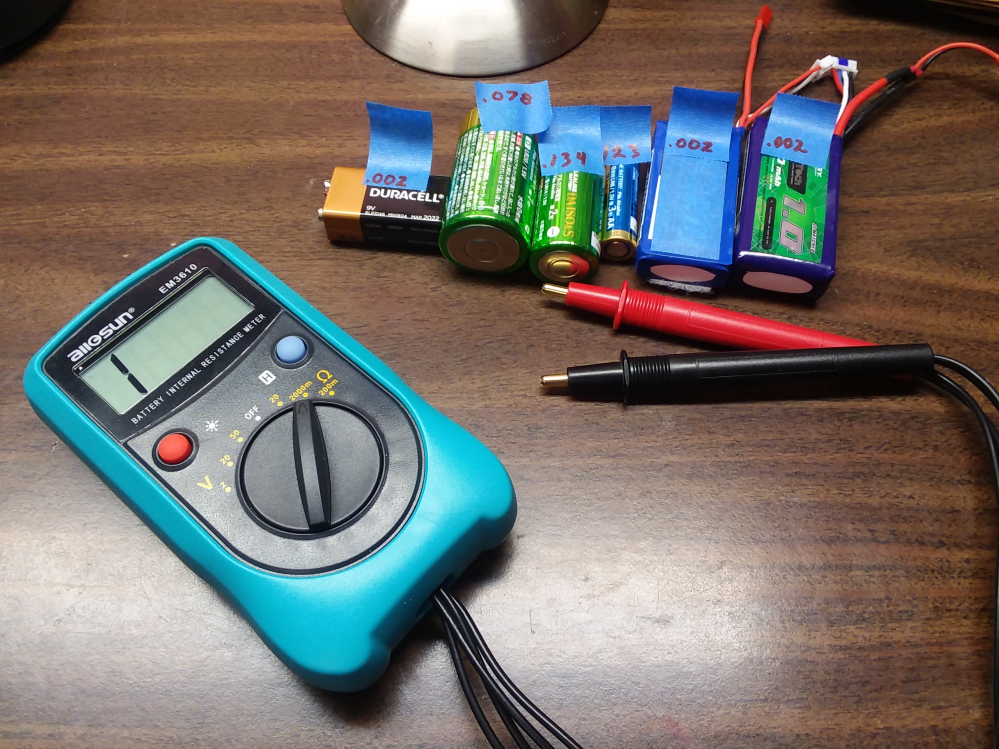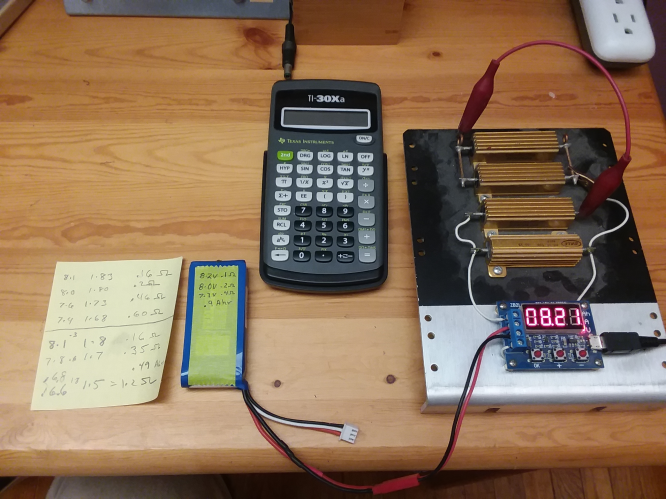Internal Resistance Meter
Walter Clark
Does anyone have experience
with internal resistance meters?
I bought this one (about $45) and it makes no sense. It seems
to read the same value 1.6 ohms no matter what the charge
state of my LiPo battery. And batteries of different sizes
read about the same.

I know how to measure it with a
current meter, a fixed load and two voltage readings and I get
.33 ohms with a fresh charge and 1.0 ohms when nearly
depleted.
Webmaster of Maglab
--
You received this message because you are subscribed to the Google Groups "23b Shop" group.
To unsubscribe from this group and stop receiving emails from it, send an email to 23b-shop+u...@googlegroups.com.
To view this discussion on the web visit https://groups.google.com/d/msgid/23b-shop/313d2b32-2be2-5d97-14e4-03bbb839068a%40roadrunner.com.
Ryan Hass
To view this discussion on the web visit https://groups.google.com/d/msgid/23b-shop/CABYPk3Dp-n-kNSSWCQWaRAfF2tRepNzxNfR9OPKaUTHWu8BMUQ%40mail.gmail.com.
Alex Whittemore
Alex Whittemore
To view this discussion on the web visit https://groups.google.com/d/msgid/23b-shop/CAHYAc299uyb7vB9BT9Ghm-ZqPmrHU4qhy%2BxByiOzJaD%3D8c25Xg%40mail.gmail.com.
Walter Clark
Walt - could you elaborate on the test procedure you used that yielded two different values?
Alex Whittemore
Yes, thanks for asking Alex...
I discharged a .95 amp-hr 2 cell LiPo in my amp-hr meter and made
internal resistance measurements periodically as the battery was
depleted.

Unloaded voltage was 8.36 V and the loaded voltages are the first
column and the difference
(the internal voltage drop) is the second column. The next column
is the current being drawn by the amp-hr meter. I = E/R turned
around is R = E/I. That's column 4.
7.8 0.56 1.70 A .33 Ω
7.4 0.96 1.65 A .60 Ω
7.2 1.16 1.60 A .72 Ω
7.0 1.31 1.58 A .83 Ω
6.8 1.54 1.54 A 1.0 Ω
The new commercial internal resistance meter reads a value of 1.6
Ω for both fully charged and depleted. Dang. And unlike the above
measurements, the meter value fluctuates from 1.5 Ω to 1.8 Ω. And
as if that wasn't bad enough a battery of about four times the
size of the above
is also about 1.6 (1.5 to 1.8) ohms. Shit.
The whole point of this meter is to determine when a battery is no good and I can throw it out.
Walt
Alex Whittemore
Alex Whittemore
--
You received this message because you are subscribed to the Google Groups "23b Shop" group.
To unsubscribe from this group and stop receiving emails from it, send an email to 23b-shop+u...@googlegroups.com.
To view this discussion on the web visit https://groups.google.com/d/msgid/23b-shop/56ff1314-33ee-e1de-5901-c9b3e706ab97%40roadrunner.com.
Walter Clark
Alex,
> anymore.
Thanks for writing the explanation.
Alex Whittemore
--
You received this message because you are subscribed to the Google Groups "23b Shop" group.
To unsubscribe from this group and stop receiving emails from it, send an email to 23b-shop+u...@googlegroups.com.
To view this discussion on the web visit https://groups.google.com/d/msgid/23b-shop/596f8601-074c-7f7e-0c7a-ccaa74f25e4b%40roadrunner.com.
Walter Clark
I think.

It is consistent in that changing scales gives similar numbers but of course with different precision. It also measures batteries of different sizes in what sort of seems to make sense: D-cell is .078 Ω, the C-cell .124 Ω. The higher voltage cells, however, have much lower internal resistance which doesn't make sense to me.
I put a current meter to see what the "test" current is in
determining the internal resistance. Well shoot. It's zero. But
then I remember somewhere it said it uses an AC voltage to measure
it. And sure enough the meter probes put out a 4 volt 1,000 Hz AC
signal.
When comparing it to the multi-step paper and pencil with
calculator method, the LiPo batteries measured on the new meter
are a lot lower; .002 Ω vs .2 Ω.

By the way thanks for suggesting referencing the "discharged"
open voltage rather than the "fully charged" open circuit voltage.
Walt
Alex Whittemore
--
You received this message because you are subscribed to the Google Groups "23b Shop" group.
To unsubscribe from this group and stop receiving emails from it, send an email to 23b-shop+u...@googlegroups.com.
To view this discussion on the web visit https://groups.google.com/d/msgid/23b-shop/42d4ceec-9e36-f16a-2114-c5aa9c8b6a45%40roadrunner.com.
